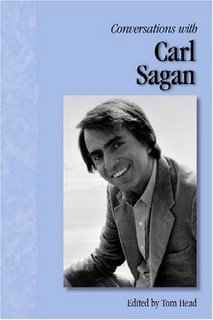Conversations with Carl Sagan

It's been just over 9 years since Carl Sagan succumbed to complications of myelodysplasia. For all that I can be overly emotional about people and situations in my life, I've never been much of a fanatic of celebrities. There are 3 people on the stage of celebrity whose deaths drew tears from my eyes though, and one of them was Sagan.
Tom Head has recently released a new collection of interviews and news stories on the man who may be the most well-known and admired of all the publicists of the human endeavour which is Science. Conversations with Carl Sagan covers twenty years of Sagan's drive to not only understand the universe in which we live, but to share both the joy and the benefits of that understanding with as many people as possible. Head quotes Sagan speaking with USNews & World Report in the introduction.
(Y)ou can see a very clear long-term trend, if you just look at the size of the group the average person identifies with. One hundred thousand years ago people identified with groups of hunter-gathers -- maybe 100 people. Today the typical allegiance is to tens or even hundreds of millions of people. [Introduction pg. xvi]Those are the kind of numbers Sagan was able to reach on the basis of both his "darkly handsom, good looks" and his peer-reviewed accomplishments as an astronomer. He approached his existence with joi de vive and awe at the immensity of possibilities which the known laws of the universe enabled.
The author alludes to how many of Sagan's critics accused the man of being too much the showman, a dreamer and even a proselytizer of science fictionesque expectations. Head's collection clarifies Sagan's personal motivations nicely in the introduction.
Pseudoscientific concepts such as astrology, crystal healing, and alien abduction were, in Sagan's view, ultimately mind-numbing appeals to authroity. Sagan argued that countering fuzzy thinking with airtight reasoning, human beings can foster a scientific attitude and thereby increase the odds that humanity will be able to accept new ideas and solve the considerable problems it faces. Although some of his critics argue that the scientific method also restricts new ideas, Sagan scoffed at the notion. "I don't think that scientists are prejudiced to begin with," he told PBS Nova, "Prejudice means pre-judging. They're post-judiced. After examining the evidence, they decide there's nothing to it." [Introduction pg. xvii]The important point is that 10 people can all look at the same thing and come up with 10 different explanations. Science involves whatever number of people looking at that thing in detail and describing it's effects and components in a clear, precise and empirical manner. It is about gaining such an understanding of that thing to the extent that 10 different people will concurr on the majority, if not all, of the conclusions of the study, after independantly judging the findings for themselves.
This collection gave me a chance to see Carl Sagan off-screen and get a better understanding of what kind of thoughts and attitudes made him such an engaging and hopeful public figure. As Head writes,
Sagan's interviews convey a humaninism, a confidence in the potential of the human race tempered by a sense of its vulnerability as a tiny hive swept about in an indifferent cosmos. This explains, in part, his passion for science --- the only way humanity has ever learned to protect itslef from the unspeakably powerful and mysterious blind forces of nature. "It's not that scientists are prejudiced towards science," Sagan told U.S. News' Stephen Budiansky. "It's that science demonstrably works better than anything else. If something else worked better, we'd be for the something else." [Introduction pg. x]I thouroughly enjoyed reading more about Sagan. If I have to provide one little quibble with this wonderful collection of the words and ideas of a man who helped me to appreciate the concept of reality, despite my lackadaisacal scholastic efforts and rebellious refusal to toe the line as I grew up, it is merely that there is unavoidable overlap when compressing 20 years of interviews into a single volume. Head's editorial composition mixed it up well though, and kept me looking forward to seeing how else Sagan might respond to interviewers of a diverse nature and from a wide variety of cultural backgrounds.
Whether or not I'm ever to find a niche in life that allows me to build a substantial Library in a permanent home, Conversations with Carl Sagan will always be, if not on the coffee table near my reading chair, then proudly ensconced on my bookshelf.
I was living in Zimbabwe at the time of Sagan's Cosmos stuff so I've missed that whole thing.
ReplyDeleteI must make the effort to read his stuff.
Who are the other 2?
Azimov and Stevie Ray Vaugn.
ReplyDeleteThe latter was just too freakin' young, man, and was a chief motivator in my gettin' serious about playing guitar. {shakin'head}
I'm not kiddin' or exagerrating 'bout how much I dig this book, either. I think it's $13 (American) via the Amazon link. It's really one of those I'll have in cloth or leather bound edition, someday.
And if you like SF, watch the movie before reading Contact. I loved 'em both but think I'd have appreciated the movie more if I'd not read the book first. That seems to be the case in a lot of instances of that sort.
Never saw any of Cosmos, but I did enjoy Sagan's Demon-Haunted World.
ReplyDeleteDHW is on my wish list.
ReplyDeleteGetting this book has already motivated me to start getting some of the other books on that list as well.
Good stuff ..